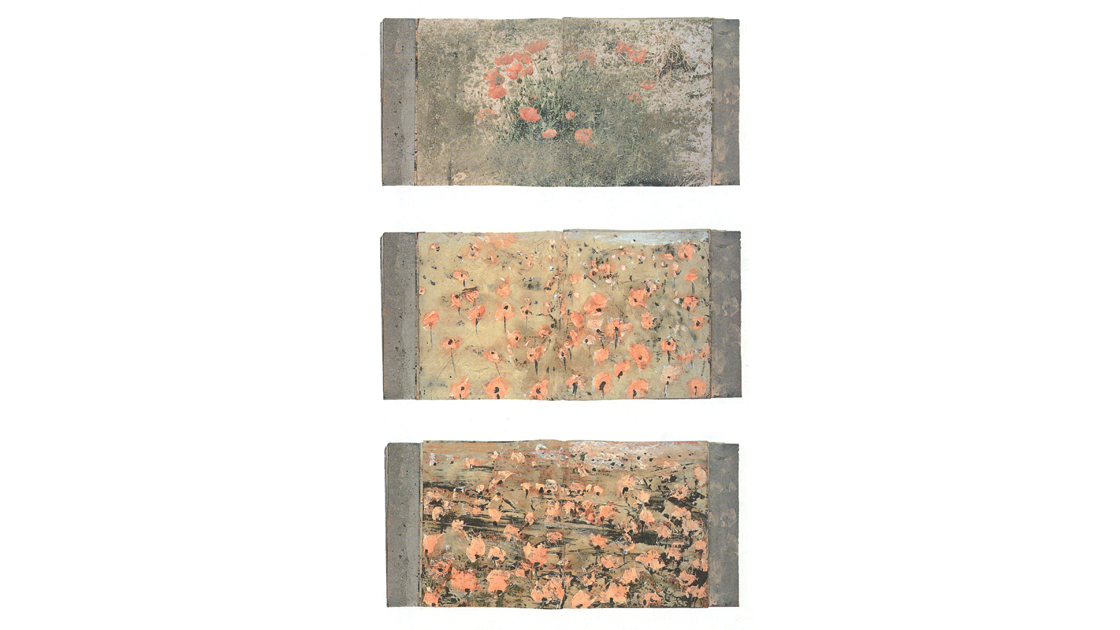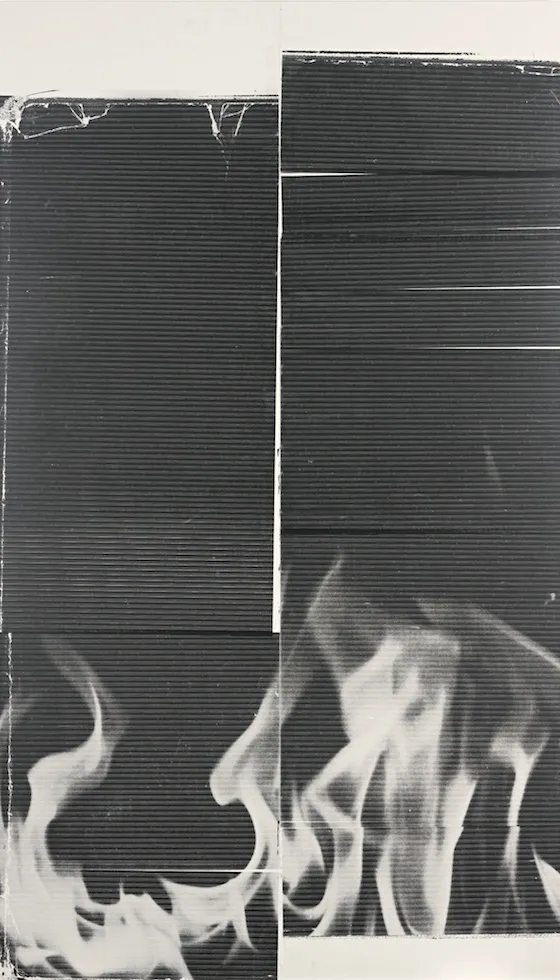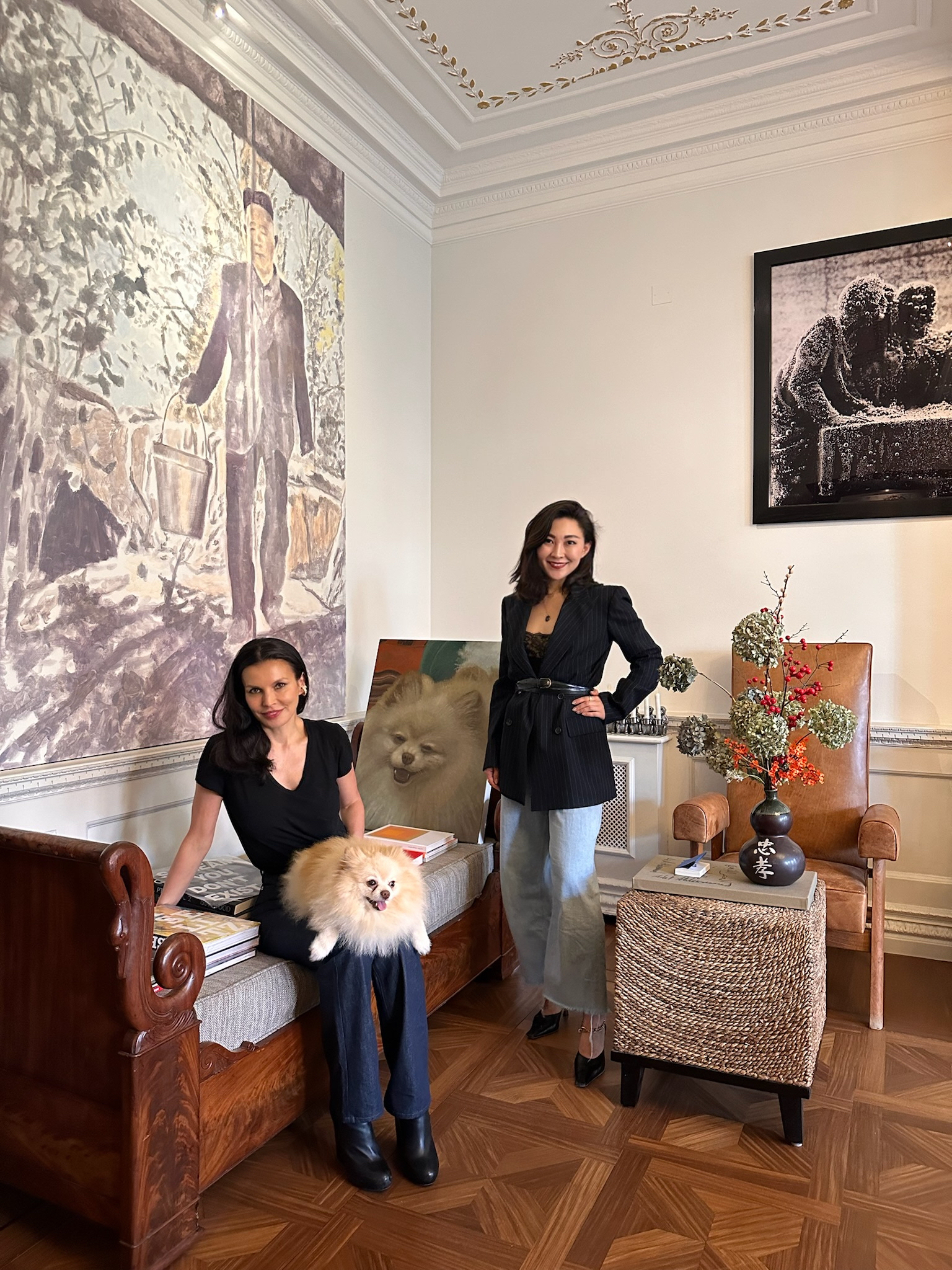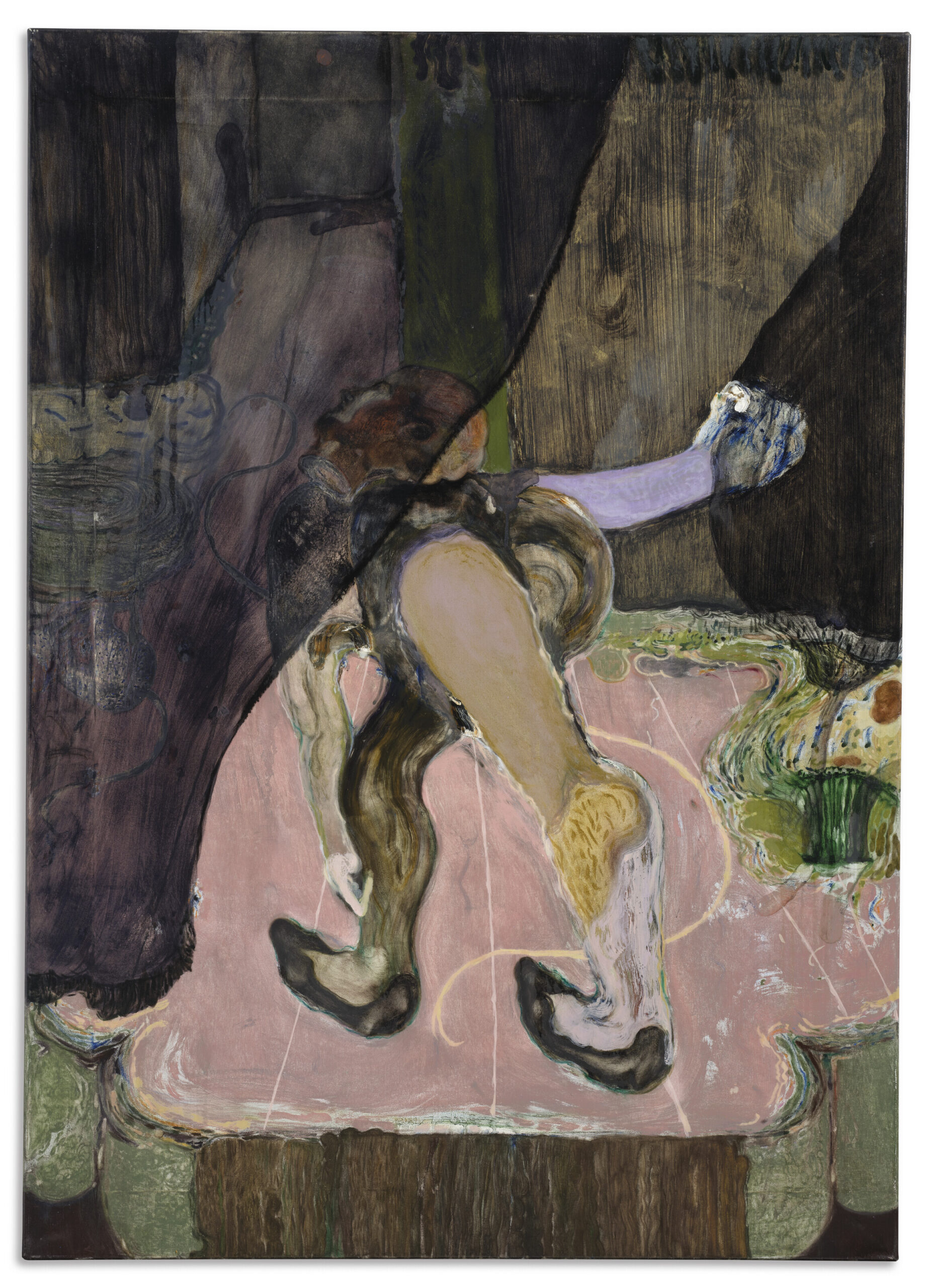
Luning and Helene Nguyen-Ban, in Helene’s London residence
A few years ago, I was introduced to the enchanting Helene Nguyen-Ban through a mutual friend. Helene, a dynamic presence straddling the cultural capitals of London and Paris, is the visionary co-founder of the Docent app. Docent aims to shatter the opacity of the art world, functioning as a “pocket art advisor.” This revolutionary platform employs artificial intelligence to connect over 20,000 artworks from more than 30 countries with the unique tastes and preferences of its collector users.

A swimming pool dedicated to Sol LeWitt / Image Courtesy: Helene Nguyen-Ban
At that time, Helene was running her own gallery in Paris’s chic Marais district. Not long after, I had the pleasure of visiting her Parisian home. As a newcomer to the world of art collecting, I was awe-struck by how collectors could so effortlessly transform their living spaces around their prized collections. Helene’s house, a former printing factory, was once the studio of Spanish artist Miquel Barcelo in the 90s. She had thoughtfully renovated the space, dedicating an entire room to Anselm Kiefer’s grand installations. The minimalist pool wall featured an homage to Sol LeWitt, while her living room displayed sculptures by Auguste Rodin, Camille Claudel, and Anthony Gormley, paintings by Zao Wou-Ki, Pierre Soulages, and Zhang Xiaogang, and video works by Bill Viola and butterfly pieces by Damien Hirst.

Pierre Soulages in the living room, works by Zao Wou-Ki, Robert Mapplethorpe / Image Credit: Billal Taright / Source: Elle Decor

Dining table from the 1930s; Chandigarh chairs by Pierre Jeanneret and Sculptures by Camille Claudel and Auguste Rodin / Image Credit: Billal Taright / Source: Elle Decor
My next visit to Helene’s residence in South Kensington, London, revealed a starkly different aesthetic. While her Parisian space exudes an industrial chic vibe with grand sculptures, her London home offers a more intimate glimpse into her life. Here, larger sculptures grace the staircases and entrance, complementing the quintessential Victorian building, which is also filled with framed works and smaller sculptures, further reflecting her evolving artistic encounters during her time in London.

With Helene at her home in London
Helene describes her London home as a “Cabinet of Curiosities,” where her collections are as cherished as family heirlooms. Her home is a reflection of her life’s journey and multifaceted identity, spanning art historical objects, antiquities, and artefacts from ancient civilisations, to works by leading and emerging contemporary artists. Initially drawn to antiques, Helene’s early collection included Tang Dynasty clay figures, religious art, Vietnamese Buddha statues, and African tribal art. Her epiphany with contemporary art came in the early 2000s when she discovered Zhang Xiaogang’s work at the Navarra Gallery in Paris, a piece that still hangs in her Parisian home.

A.R. Penck, ‘Lava Ausdehnung’, 1998 and Antique Ava Buddha

Helene Nguyen-Ban portrait with Marguerite Humeau, ‘Noxcalidus’, 2022 / Image Courtesy: Elliot James Kennedy

Helene Nguyen-Ban’s home in Paris

Zhang Xiaogang, ‘Bloodline Series’, 2001
Helene’s multicultural upbringing—spanning Africa and Europe, with a Vietnamese father and an Alsatian French mother—naturally led her to works exploring the complexity of personal identity. Her extensive collection can be traced along key themes of “identity” and “personal experience.” She gravitates towards works by Vietnamese artists like Danh Vo, Mai-Thu Perret, and Thu-Van Tran, and African artists such as Pascale Marthine Tayou, Lynette Yiadom-Boakye, and Danielle McKinney.

Lynette Yiadom-Boakye, ‘Advice’, 2007

Helene Nguyen-Ban, portrait with Pol Taburet, ‘Lip Pulp’, 2021; Raphaela Simon, ‘Halber Kopf(Half a Head’, 2022 and Antiques / Image Courtesy: Kathie Kay
Helene notes the significant shifts in the art world over the past two decades. Once dismissed as “kitsch,” Asian and African artists now gain acclaim for their cultural explorations and identity themes. Her collection includes thought-provoking works by Jem Perucchini, Xinyi Cheng, Alvaro Barrington, and Oscar Murillo. Influenced by her mother’s Alsatian heritage, her collection also features German artists like Georg Baselitz and Anselm Kiefer, and Belgian artists Bendt Eyckermans and Luc Tuymans.

Jem Perucchini, ‘Partita Di Scacchi’ 2022

Anselm Kiefer, ‘The Secret Life of Plants’, 2001

Luc Tuymans, ‘Inland’, 2018

Bendt Eyckermans, ‘The Phantom’, 2019
After moving from Africa to France, Helene uncovered numerous emerging talents who are now highly sought after, such as Camille Henrot, Julie Curtiss, Marguerite Humeau, Nathanaëlle Herbelin, and Pol Taburet. Now partly based in London, she actively supports the local art scene, engaging with prestigious institutions like Tate Modern, Goldsmiths, and Gasworks. She has also amassed works by London-based artists like Oscar Murillo, Issy Wood, Lynette Yiadom-Boakye, Alvaro Barrington, and Sin Wai-Kin.

Issy Wood, ‘Very sick on the subway’, 2020

Alvaro Barrington, ‘St. Vincent GBY M’

Marguerite Humeau, ‘Noxcalidus’ ,2022

Julie Curtiss, ‘Triplette (Triplet)’, 2019
Helene’s South Kensington home is meticulously curated. At the entrance, Wade Guydon’s works juxtapose with Victorian stained glass windows—complementing historical craftsmanship with contemporary technology. The hallway and staircase highlight the reproducibility of art in the digital age, featuring works by Wade Guydon and Christopher Wool. Helene has been particularly intrigued by the exploration of painting’s potential in an era marked by technological reproducibility, which is evident in her thoughtful curation.

Christopher Wool, ‘Untitled (P 583)’, 2009

Wade Guyton, ‘Untitled’, 2018

Wade Guyton, ‘Untitled’, 2018 / Image Source: Frieze

Luning with Helene and her dog, Opium
A floor-to-ceiling sculpture of stacked Chinese jars by Pascale Marthine Tayou, an artist who navigates between Africa and Europe, mirrors Helene’s own journey. Another poignant piece on her staircase is Marlene Dumas’s “Not going to tell you where I come from, nor where I am going to” (2005). Dumas’s words resonate deeply with Helene: “Someone once told me I couldn’t be both a South African artist and a Dutch artist. But I don’t want to be just both—I want to embrace even more identities.”

Portrait with Pascale Marthine Tayou, ‘Colonne Pascale’, 2013 and Baselitz, ‘Elke negativ blau’, 2012 / Image Courtesy: Elliot James Kennedy

Marlene Dumas, ‘The Boy Next Door’, 2001
In her ground floor drawing room, Helene has dedicated a space to portraits and figurative works by female artists, including Jenny Saville, Elizabeth Peyton, Marlene Dumas, Lynette Yiadom-Boakye, and Danielle McKinney. Young artists like Nathanaelle Herbelin and Ethiopian artist Jem Perucchini also feature prominently. Helene’s special connection to portraiture and figurative painting centres on exploring fractured personal identity, drawing from life experiences and the way geographic locations and cultural identities inform our sense of self.

Elizabeth Peyton, ‘Lara February’, 2022

Nathanaëlle Herbelin, ‘Redhook Cocktail’, 2023
On the other side of the living room is her friend Andres Serrano’s photograph Immersion (Black Supper IV), a large polyptych that recreates Leonardo da Vinci’s Last Supper. In this work, Christ and his apostles are submerged in bubbling liquid, similar to the effect in Pissing Christ (1987), casting a veil of darkness over the biblical scene. The bubbles in the picture are like ash, which makes the picture full of mystery, and the grand Pompeii-like scene and the special texture of ash, frozen in time, also suggest that faith and religion are becoming increasingly irrelevant.

Andres Serrano, ‘Immersions Black Supper IV’, 1990


Guglielmo Castelli, ‘Trofallassi’, 2019
Across from the drawing room, the focus shifts to Neo-Surrealism, a long-standing interest of Helene’s. Above the fireplace hangs Bendt Eyckermans’s 2019 piece “The Phantom,” alongside Guglielmo Catelli’s “Trofallassi” (2019). Recent paintings by Jean-Marie Appriou, Marguerite Humeau, and Issy Wood complete the display. Notably, Issy Wood created a captivating portrait of Helene’s dog Opium, titled “Opium Over the Holidays,” a testament to the close relationships Helene fosters with artists.

Issy Wood, ‘Opium over the holidays’, 2021 – Courtesy of the artist.
Helene’s total immersion in the art world has led to friendships with many artists, resulting in bespoke creations for her. Above her staircase are portraits of her daughters by Franco-Vietnamese photographer Jean-Baptiste Huynh. While her daughters now pursue interests in maths and science, Helene’s passion for art remains undiminished. Growing up in a traditional Vietnamese household, her father viewed art as an impractical pursuit. It was during her tenure at Louis Vuitton that she realised the ultimate luxury lies in turning one’s passion into a lifelong career. She subsequently left her job and enrolled at the École du Louvre to study art history, opening her gallery in the Marais in 2013.

Helene while working for Louis Vuitton by Marc Jacobs
Helene’s dual roles as a collector and gallery owner provide her with unique insights into the contemporary art world’s limitations and possibilities. The art market, often opaque and exclusive, can mislead collectors, causing them to overlook talented artists not spotlighted by the market. Galleries, too, struggle to connect with new audiences. The pandemic underscored the importance of online platforms, turning Helene’s bold vision into reality. She conceived Docent to help collectors and enthusiasts discover and purchase art. Collaborating with mathematician Mathieu Rosenbaum, she launched Docent, the first AI-driven app for art discovery and acquisition. Docent offers a dynamic inventory shaped by local incubators of the world, and proprietary algorithms backed by AI expertise understand artistic nuances and collector preferences. This aims to create a virtuous cycle in the art market, showcasing over 20,000 carefully selected artworks from more than 200 galleries worldwide, breaking down information barriers and revitalising the market.

Helene explaining her art collection to guests
For Helene, maximising impact in all life’s facets is paramount. On top of her current role at Docent, she currently serves as Chair of the board of Fluxus Art Projects – which supports artistic creation on both sides of the FR-UK Channel – and on the International Council of Tate, the Asia-Pacific Committee at Centre Pompidou, Palais de Tokyo, and is part of the jury for the AWARE as well as the Fluxus Prizes at Frieze London and Art Basel Paris. Art, for Helene, is not just a career but a way of life, guiding her every decision. It is her passion and mission, and she delights in sharing this with others.
-the end-
Text: Luning
Copyediting: Rosie


